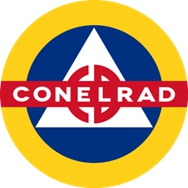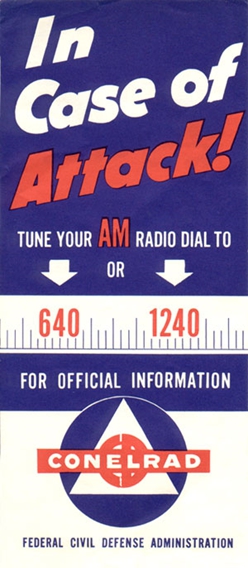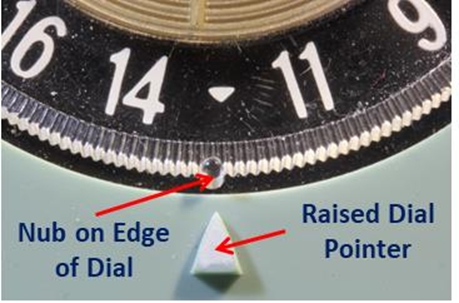Many thanks to SWLing Post contributor, Bob Colegrove, who shares the following guest post:
Control of Electromagnetic Radiation (CONELRAD)
As recalled by Bob Colegrove
In his comment on my recent posting, Tinkering with History, Mario noted the dial on the featured radio, the General Electric P755A, sported two small triangles, one between 6 and 7, and the other between 11 and 14. He noted that these were civil defense markers intended to show the frequencies of 640 kHz and 1240 kHz, respectively, and that these were characteristic of AM radios produce in the US roughly between 1953 and 1963. Since two full generations have been born and raised to adulthood since that time, and I can’t find any related posting here, I thought it might be useful to bring this subject to light.
In spite of otherwise economic prosperity and general wellbeing, these years were nevertheless filled with anxiety about the prospects of all-out war. Children of the time (myself included) were being shown how to hide under their school desks, and some of their parents were going so far as to construct air-raid shelters in their basements, and stock them with enough provisions to supposedly outlast any catastrophe. So it was that CONELRAD came into being in 1951. The idea was, that in case of a National emergency, all radio and TV stations would go off the air, and only certain medium wave radio stations would stay on either 640 kHz or 1240 kHz. They would remain on for a few minutes and then other stations would take over in a round robin arrangement – this to deter homing by hostile bombers. Needless to say, quickly changing over transmitters and antennas to one of these two frequencies did not bode well for the equipment and there were many failures in subsequent tests. Note that, as originally conceived, the system did not provide for local weather emergencies or other situations.
The banner photo at the top of this posting shows a portion of the Hallicrafters S-38E receiver which conformed to Government law of the time required for marking all AM dials. An S-38E just like it was my first genuine multi-band radio in 1959. Assuming good alignment, the dots next to the CD triangles indicated the 640 kHz and 1240 kHz frequencies. When a test came on, you didn’t have to fish for it, since CONELRAD was the only service transmitting.
Going back to the radios described in Tinkering with History, GE took this one step further. The figure below shows a portion of the dial on a GE P806A. Note the nub on the outer edge of the dial under the triangle at 1240 kHz. There is another nub on the edge at 640 kHz. Together with the raised triangular dial pointer molded on the cabinet, they provided a braille system, so that someone visually impaired could easily tune to a CONELRAD frequency.
As technology improved, CONELRAD transitioned to the Emergency Broadcast System (EBS) in 1963, and subsequently the Emergency Alert System in 1997. A more thorough description of CONELRAD can be found on Wikipedia https://en.wikipedia.org/wiki/CONELRAD. Reprint of an April 1955 Radio & Television News article describing the construction of a transistor CONELRAD receiver is at https://www.rfcafe.com/references/radio-news/conelrad-radio-television-news-april-1955.htm.





Bob, thank you for mentioning me in your article. Those of us who were brought up in the cold war era would remember the CONELRAD system, along with its weekly testing over the radio. During that era, car radios, which were pushbutton types, also had CD markings. Thank you for another excellent nostalgic piece.
Yes. I had my Tech as well. Been a Sixer ever since. IGY was a wonderful year! The Gonsicator was borrowed.
This is beyond amazing; I found an early fifties blue Motorola Model 56lA Portable/AC swivel handle antenna radio on eBay two weeks ago and it arrived Yesterday. In 1954, as poor as we were, my Mother put together enough money to buy one for my 8th grade graduation, and it was a treasure. Lost track of it after my wife and I married in 1964 and moved several times. I been searching ever since, not having many items left from my youth.
Have seen several over the past decades on eBay, but in absolutely poor shape and none having a power cord. . . . until two weeks ago. It works and is in wonderful condition ($36.) First thing I looked for, remembering the old Conelad logos.
The point of this lengthy story. . . . I started searching last night for info regarding APRS and THIS showed up today.
Don
N4TFF
My Novice license opportunity came thanks to the Local town’s CD folks. Around 1964 A group of five of us got together weekly in the HS basement to study theory together and of course copy code. There was a net we would listen to that sent five ir six letter/number sets in increasing speeds. Our instructors, aside from all being pretty serious hams, were WWII or Korean graduates. We even had a couple of surplus jeeps to be run around in to support local events like Easter Egg Hunts)
Three of us were successful as I recall, and I egan my amateur career as WN2RJD; with a surplus An/ARC 4 as a transmitter and a borrowed CD Gonset Comm III. Yes in glorious bright yellow with the CD decals on both sides. Powerful ‘little’ bugger it was. Of course the big guys had Comm 4s but they were smaller, grey and just didnt look the part of a serious piece of emergency equipment.
Some days those early 60’s!
dave
KC4XU
I forget that my first transceiver was a Gonset Gonsicator, the yellow Civil Defense model: http://www.ipernity.com/doc/777361/42320650 Other than the bright yellow color and the CD badge, I don’t know what made these different. In ’57 these things could work Europe from W2-land on AM.
Of course Civil Defense is separate from Conelrad, even if broaecast receivers used “CD” to mark the Conelrad frequencies.
Civil Defense isn’t just in case of nuclear war. It’s snowstorms and floods, all kinds of emergency situations. And at such times, communication is important. Ham radio could traditionally provide that, at a time hams were the only civilians with radio.
The yellow Communicators were not different from regular Communicators. But enough were bought by CD programs that it was worth painting them differently. It helped to distinguish the two, harder for someone to walk away with one.
That had to be on 6M to reach Europe with a Communicator.
Don’t forget, US hams were obligated to stop transmitting in the event of a Conelrad alert, starting in 1957. So you had to monitor a station, and go off the air if needed.
There were lots of projects and schemes in the magazines, and some commercial units to check and disable the transmitter.
It loomed so large at one point, but looking back it was a brief period.
Two additional systems never made it beyond the experimental phase. These included NEAR, the National Emergency Alarm Repeater over AC power lines; and DIDS, the Decision Information Distribution System also known as Public Emergency Radio. The DIDS prototype station in Maryland was a strong LF signal in the 1980s.
Today the Emergency Alert System (EAS) is part of IPAWS, the Integrated Public Alert & Warning System which also includes Wireless Emergency Alerts (WEA), Non-Weather Emergency Messages (NWEM) over NOAA Weather Radio, and the IPAWS All-Hazards Information Feed to digital devices.
This brings back memories. I remember it well and I still have a S-38E, my first Rx when I was licensed in 1957 as WV2ECZ. There was a lot of talk about shelters but I don’t know of anyone who had one, and I don’t even recall the ‘get under the desk’ thing. And our History teacher had been in the RAF in WW2!
Here is a link to a rare set of recordings of civil defense announcements from 1961 that would have aired on WCCO Radio (MInneapolis, MN) in the event of a probable or actual enemy (nuclear) attack. These announcements were pre-recorded by WCCO announcers and Governor Elmer Andersen, and most likely would have aired from the station’s transmitter facility in Anoka which included a fallout shelter. http://radiotapes.com/WCCO/WCCO-AM_Civil_Defense_1961.mp3
Very interesting, thanks for posting!